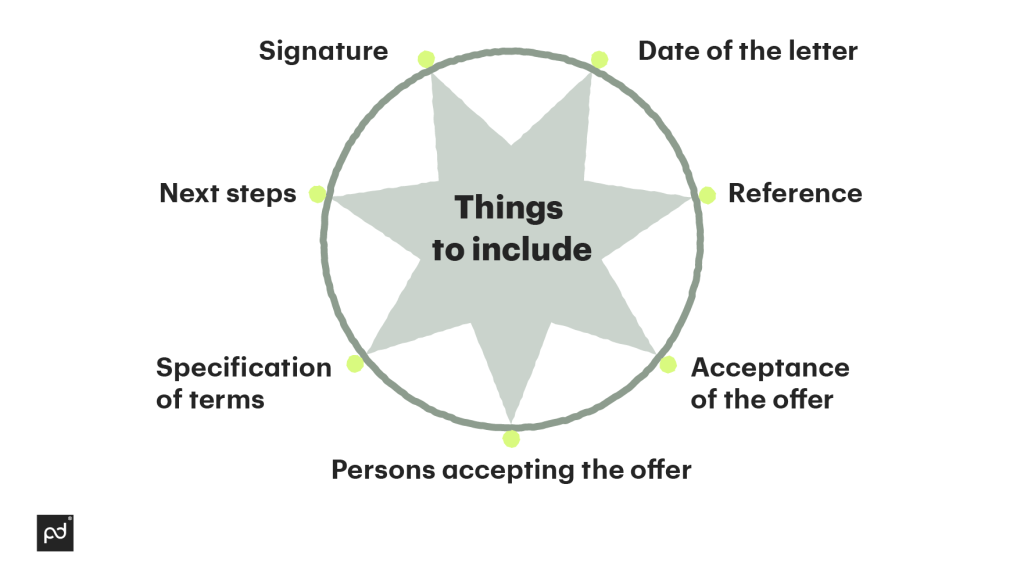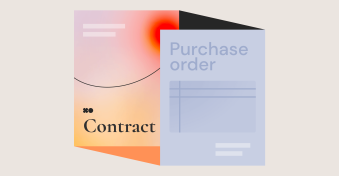A contract acceptance letter is a formal letter by which you accept the terms and conditions of a business contract.
Normally, you’re required to issue a formal acceptance or a counteroffer against an offer or proposal within a set amount of time.
If you’re ready to accept the offer as is, your letter should include statements signaling your acceptance of the terms.
From a legal perspective, an acceptance letter typically indicates your agreement to a binding contract.
This letter has legal weight and can lead to regulatory implications if you aren’t exactly sure what you’re signing.
This article will explain how to write contract acceptance letters and what to keep an eye on before you sign on the dotted line.
Key takeaways:
- Letters of acceptance for contracts are generally straightforward documents that have legal power.
- They can be used in many situations — from employment offers to the acceptance of a business proposal.
- Contract acceptance letters must be accurate and can be created easily with professional business templates.
Why are contract acceptance letters important?
Contract acceptance letters formalize the agreement between two parties.
These documents state that you have read and agreed to the terms of the contract.
It also serves as a record of the agreement, which can be used in the event of a dispute.
In many ways, issuing an acceptance letter carries the same legal ramifications as signing contracts, although the preparation and dispatch of a letter tend to be a more formal process.
These letters are legally binding documents that confirm an agreement between parties.
They can be used in court or other legal settings to prove that the contract was accepted by the parties involved.
When should you write an acceptance letter?
Letters of acceptance are usually written in response to an offer issued by the other party in the contract.
This might be a business extending a job offer to a candidate, a company accepting a business proposal from another organization, or a corporation offering a franchising opportunity to a new franchisee.
So, if you receive an offer for a job, role, or contract after successfully applying for a position, it is expected of you to write and send an acceptance letter. By creating and signing this document, you will formally accept the offer.
A tip here would be to adopt the use of a modern e-signature tool, which not only ensures secure document signing but also significantly reduces the time needed to process docs.
You can join the club of nearly 100 thousand PandaDoc accounts who have already elevated their document processing by using e-signatures.
How to write a contract acceptance letter
Writing a flawless letter of acceptance is simpler than you might think.
We’ll walk you through the essentials of creating this document: what to include and what to steer clear of while writing one.
You’ll also discover ready-to-use samples to help you draft acceptance letters in no time.
Things to include in your acceptance letter
Just like every contract has essential elements to ensure its credibility, a contract acceptance letter requires a few important aspects in order to provide clarity and context to a reader.
These details connect the acceptance letter directly to the contract or offer you’re writing about.
First off, consider the tone of the acceptance letter and whether it needs to convey any additional information.
Often, acceptance letters are written as thank you letters, thanking employers for a job offer or businesses for submitting a proposal.

While this isn’t strictly required, it’s considered a good form to show gratitude in a letter of acceptance.
Date of the letter
The date on the letter should reflect the send date and the formal date of acceptance for the contract in question.
Reference to the original offer or contract
Either in the body, the text, or the subject line at the top of the letter, you’ll want to refer to the offer, proposal, or employment contract that you intend to accept.
In an acceptance of a proposal letter or similar document, you might also have a proposal number that you can use as a reference when accepting the terms of the contract.
Acknowledgement and acceptance of the offer
Somewhere in the official letter of acceptance, you need to formally accept the offer.
This is essential to the letter of acceptance since it formally acknowledges the sender’s intent to accept the contract award.
Parties or entities accepting the offer
In your acceptance letter, you’ll need to specify the parties accepting the offer.
In business letters, this might be covered by using company letterhead, but it’s often best to use the company name if you are accepting on behalf of an organization or collective entity.
Counteroffers and specification of terms
In some scenarios, you may need to clearly specify terms made as part of a counteroffer or counterproposal.
Be sure to include this in your letter of acceptance if you feel that there is any confusion regarding these conditions.
Further discussions and next steps
If you plan to initiate future conversations or are in charge of the acceptance process, you may want to clarify what should happen next upon acceptance.
This might include setting up dates for future discussions, specifying an operational start date, or providing additional information to interested parties.
Signature or signoff of the sender
You need to include a signoff or signature to conclude the formal document. Typically, this includes your name, contact information, and job title (in business situations).
What to avoid while writing a contract acceptance letter
When it’s time to accept the terms and conditions offered to you, be clear, concise, and direct so that everyone is on the same page.
With that in mind, here is a list of things to avoid while writing your contract acceptance letter.
Being vague
Above all else, your letter of acceptance should clearly state that you are accepting the provided offer.
This is the entire purpose of a letter of acceptance, and it should be evident to the reader from very early in the letter that acceptance is your intended goal.
Replying to the wrong recipient
Sometimes, a letter of offer is generated from a location that isn’t connected to your intended recipient.
For example, an email with your offer letter might be sent from an email address that only sends contract documents.
Before replying (either by letter or by email) be sure that you’re addressing your formal acceptance to the appropriate individual.
Failing to do so could mean that your acceptance letter is never received or processed.
Accepting while still negotiating terms
The issuance of a letter of acceptance indicates that you are accepting the terms of a given contract or offer.
While you can accept with contingencies, it’s often better to wait until all negotiations are complete before officially accepting or finalizing the offer.
Failing to reference the original documentation
Somewhere in your acceptance letter, you’ll need to reference the initial documentation that was provided to you.
This might be a hiring contract or a business proposal.
The letter of acceptance should clearly indicate what offers you are accepting and when you intend to accept it.
Especially in B2B relationships, when multiple vendor contracts may be open at a time, directly referencing specific proposals is essential to keep all parties aligned.
Contract acceptance letters: templates and samples
Below, you’ll find samples you can copy and paste and then edit to create your letter of acceptance. You can also tap into professional business templates to make the drafting process simple and ensure your letter meets all expected standards.
Template: Job offer acceptance letter
Dear Mr. / Mrs. [LAST NAME],
Thank you so much for considering my candidacy for [JOB TITLE] at [ORGANIZATION]. I am excited by your offer and am very happy to accept.
Please contact me at your earliest convenience regarding the next steps and training dates. Thank you again for the offer and for choosing to work with me.
Sincerely,
[NAME]
Template: Acceptance of proposal letter
[NAME],
Good [MORNING/AFTERNOON]! I’m reaching out regarding [PROPOSAL], the proposal that your company submitted in response to our RFP, [RFP NAME].
I’m excited to let you know that my team has reviewed all proposals and would like to proceed with your offer.
Currently, we anticipate a start date of [DATE] with an end date of [DATE], based on the work schedule attached to your bid. Can you confirm that this information is correct?
If you are still available for the requested work, please contact me as soon as possible to finalize the remaining details.
We are excited to work with you!
[NAME]
[COMPANY]
[CONTACT INFORMATION]
Template: Event acceptance letter
Dear Mr. / Mrs. [LAST NAME],
I am excited to confirm my attendance of [EVENT] at [LOCATION] on [DATE].
In your invitation, you requested information regarding any additional guests. I plan to attend with [FULL NAME] during this event.
Please keep me informed of any changes regarding scheduling, wardrobe, or attendance.
Thank you for the kind invitation.
Sincerely,
[NAME]
Transform your contract workflow with PandaDoc
Whether you’re sealing a deal or accepting a job offer, you can use effective tools to automate the process of all document creation and management, including the creation of professional acceptance letters.
With customizable templates, the PandaDoc platform makes generating and sending acceptance letters hassle-free — rest assured your letter will leave a positive impression.
You can include your letter of acceptance in the body of an email or use electronic signature software as a simple and secure way to verify documents.
Start a free 14-day trial and explore the most efficient way to manage your document workflows!
Disclaimer
PandaDoc is not a law firm, or a substitute for an attorney or law firm. This page is not intended to and does not provide legal advice. Should you have legal questions on the validity of e-signatures or digital signatures and the enforceability thereof, please consult with an attorney or law firm. Use of PandaDoc services are governed by our Terms of Use and Privacy Policy.
Originally published November 29, 2022, updated July 12, 2024


